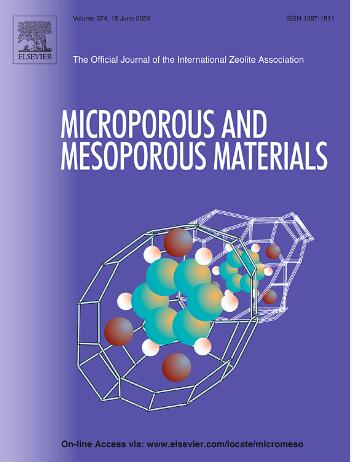Synthesis of spherical mesoporous silica beads with tunable size, stiffness and porosity
IF 4.8
3区 材料科学
Q1 CHEMISTRY, APPLIED
引用次数: 0
Abstract
We present an innovative template-free water-based sol–gel method to produce uniform mesoporous silica beads of millimeter size, which have tunable size, stiffness and porosity, and could be used for adsorption applications. Our protocol exploits an in-situ enzymatic reaction to produce spherical beads of hydrogel from a charge-stabilized suspension of silica nanoparticles confined in a millimetric drop suspended in a non-miscible oil. Once the gelation step is complete, the spherical bead of gel is cleaned from oil and deposited onto a hydrophobic surface and let dry. Separating the gelation to the drying steps ensures a spatially uniform gel and allows us to perform a solvent exchange before drying. For all beads, we observe a crack-free drying process leading to the formation of stiff quasi-spherical beads with diameter in the range 1 to 5 mm and Young modulus in the range and narrow pore size distribution, centered around 10 to depending on the experimental conditions. Finally, to demonstrate the potentiality of these materials, we graft on the bead surface aminosilane molecules, and quantify their CO adsorption efficiency. Overall, the production method we have developed is simple, readily adaptable, and offers promising materials for adsorption, storage, catalysis and chromatography.

求助全文
约1分钟内获得全文
求助全文
来源期刊

Microporous and Mesoporous Materials
化学-材料科学:综合
CiteScore
10.70
自引率
5.80%
发文量
649
审稿时长
26 days
期刊介绍:
Microporous and Mesoporous Materials covers novel and significant aspects of porous solids classified as either microporous (pore size up to 2 nm) or mesoporous (pore size 2 to 50 nm). The porosity should have a specific impact on the material properties or application. Typical examples are zeolites and zeolite-like materials, pillared materials, clathrasils and clathrates, carbon molecular sieves, ordered mesoporous materials, organic/inorganic porous hybrid materials, or porous metal oxides. Both natural and synthetic porous materials are within the scope of the journal.
Topics which are particularly of interest include:
All aspects of natural microporous and mesoporous solids
The synthesis of crystalline or amorphous porous materials
The physico-chemical characterization of microporous and mesoporous solids, especially spectroscopic and microscopic
The modification of microporous and mesoporous solids, for example by ion exchange or solid-state reactions
All topics related to diffusion of mobile species in the pores of microporous and mesoporous materials
Adsorption (and other separation techniques) using microporous or mesoporous adsorbents
Catalysis by microporous and mesoporous materials
Host/guest interactions
Theoretical chemistry and modelling of host/guest interactions
All topics related to the application of microporous and mesoporous materials in industrial catalysis, separation technology, environmental protection, electrochemistry, membranes, sensors, optical devices, etc.
 求助内容:
求助内容: 应助结果提醒方式:
应助结果提醒方式:


